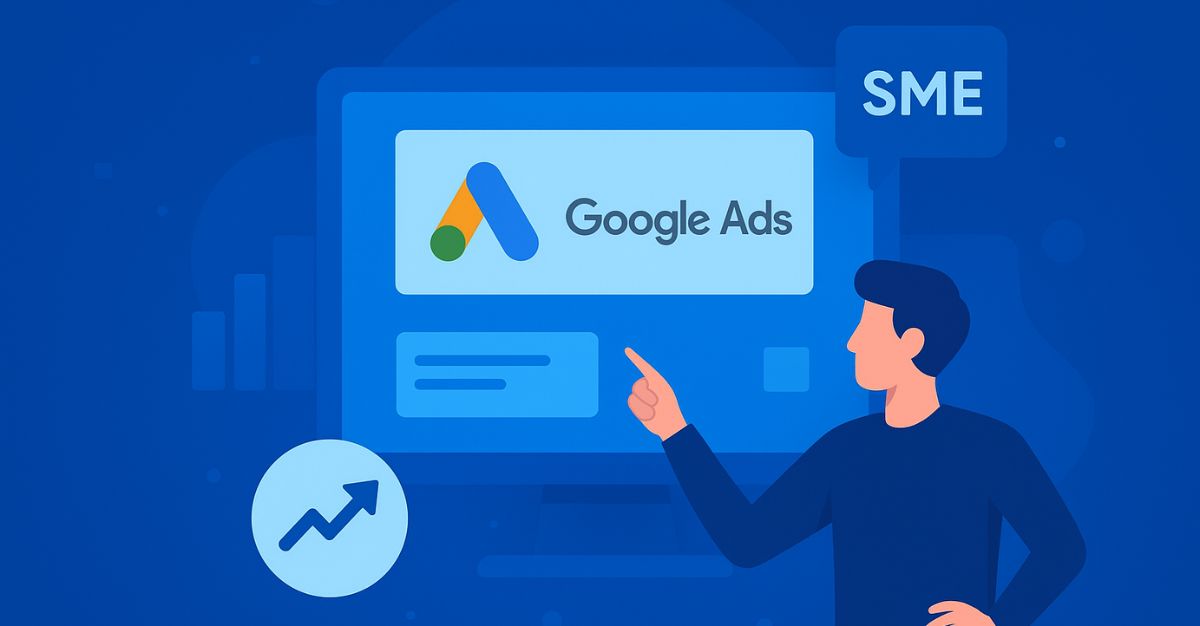Running Google Ads for SMEs can feel like stepping into a boxing ring with heavyweights when you’re carrying a featherweight budget.
Big competitors can stretch advertising costs far beyond your comfort zone, but smaller firms can still deliver results with the right advertising strategy.
By leaning on precision, SMEs can run lean ad campaigns that capture leads and fuel small business growth.
This guide shares practical ways to stretch spend, win better leads, and shape smarter campaigns for long-term impact.
Table of Contents
Smart Budget Management: Where Every Pound Works Harder
Every pound in your advertising budget must serve a purpose. Spray-and-pray approaches across multiple campaign types rarely work when funds are tight.
a. Focus on High-Intent Keywords
High-intent searches like “enterprise CRM software pricing” carry stronger conversion rates than broad queries such as “what is CRM”.
Though clicks cost more, return on ad spend usually improves. SMEs can sharpen this process further with keyword research backed by proper market research.
If you need a bigger picture view, check out Google Ads Malaysia for strategies tailored to the region.
b. Funnel-Based Budget Allocation
Here’s a common funnel-based approach to budget allocation for digital marketing campaigns:
| Funnel Stage | Budget % | Campaign Focus |
| Top (Awareness) | 20% | Display ads, video ads for brand awareness |
| Middle (Consideration) | 30% | Informational keywords, remarketing campaigns |
| Bottom (Decision) | 50% | High-intent search campaigns, competitor terms |
c. Geographic and Industry Precision
Geotargeting keeps local advertising sharp by narrowing campaigns to relevant regions. A Manchester HR provider, for example, gains nothing from clicks in Aberdeen.
Likewise, audience targeting by job title or industry means your target audience sees ads that reflect their reality.
For SMEs that rely heavily on local services ads, narrowing the radius prevents wasted clicks and increases ad relevance.
Keyword Research That Protects Your Wallet
Keyword research must be surgical when budgets are thin. Broad matches soak up fast.
a. Long-Tail Keywords Beat Broad Terms
Specificity matters. Instead of chasing “accounting software”, try “cloud accounting software for construction SMEs”.
Such terms draw small business owners who already know what they want, lowering cost per acquisition and boosting return on investment.
b. Negative Keywords Save Budgets
Add negative keywords like “free”, “jobs”, or “tutorial” to cut irrelevant clicks. Review the search engine results inside your Google Analytics or Ads dashboard weekly.
Keep pruning so that pay per click spend goes only to prospects who fit.
c. Competitor Keywords: Handle With Care
Bidding on rival names can work. For example, “Salesforce alternative for small business owners”.
The tactic must be backed with strong ad copy, compelling call to action, and landing pages that clearly highlight your advantages.
Creating Ads and Landing Pages That Convert Decision-Makers
Decision-makers look for outcomes, not buzzwords. Your ad copy should spell out numbers, results, and clear CTAs.
a. Ad Copy That Speaks to Business Goals
❌ “Streamline your operations with our platform”
✅ “Cut invoice processing time by 60% | Free 14-day trial”
Always connect benefits directly to business goals like cost savings or productivity. Strong visuals, case studies, or video content reinforce your message.
b. Ad Extensions Add Trust
Use ad extensions to secure more visibility in the search network:
- Callouts: “24/7 UK Support”
- Sitelinks: case studies, demo booking
- Structured snippets: industries served
c. Landing Pages That Match Intent
Your landing pages should carry the promise of your ad through to the customer journey. If the ad sells “ERP for manufacturers”, the landing page must show manufacturing-specific details.
Pages that offer lead magnets like a free guide can also improve website traffic and nurture longer sales cycles.
Well-built pages should load fast, feature a single call to action, and reassure with trust signals. Our corporate website services help SMEs build ad-ready experiences that match ad formats and intent.
Smart Bidding and Automation for Limited Budgets
Smaller teams can compete by leaning on bidding strategies and automation.
a. Target CPA and ROAS Bidding
Start with manual bidding to gather clean data, then move to target CPA or Target ROAS once you’ve got at least 30-50 conversions.
These methods balance campaign performance by telling Google how much you’re willing to spend to secure a lead or pound of revenue.
b. Performance Max for Multi-Channel Reach
Performance Max campaigns stretch across the display network, YouTube, Gmail, Discover, and more. For SMEs, it’s effective when your target audience interacts across multiple touchpoints.
Strong audience targeting signals, first-party data, and customer lists are vital. This becomes even more important in a world shifting toward cookieless Google Ads.
c. Maximise Conversions on Tight Budgets
The maximise conversions strategy spends your daily limit wisely, letting Google optimise in real time. For businesses that need simplicity, this balances budget management with automation.
Tracking Performance and Scaling Sensibly
Strong tracking separates guesswork from profitable ad campaigns.
a. Connect Conversion Tracking Properly
Basic conversion tracking stops at form fills or phone calls. Advanced methods tie leads directly to revenue using CRMs like Salesforce or HubSpot. For eCommerce SMEs, syncing shopping ads or eCommerce SEO strengthens visibility and improves long-term lead generation.
b. Review Campaign Performance Weekly
Monitor these performance metrics every week:
- Quality score for cost control
- Impression share for visibility gaps
- Ad performance by device
- Conversion rates across campaigns
Pause any keyword that burns through clicks without results. Reinvest in channels driving measurable leads.
c. Scale With Care
Scale slowly,around 20% budget increases at a time. To let algorithms adapt. Rapid scaling risks skewing results.
Turning Small Budgets Into Quality B2B Leads
Winning with a lean marketing budget takes sharper thinking, not bigger spend. Precise audience targeting, disciplined budget management, and refined ad campaigns can deliver stronger return on investment.
The SMEs that thrive do three things well: they know their target audience, they monitor every part of the customer journey, and they constantly refine ads based on hard data.
Rivals might dominate with higher advertising costs, but smart strategy beats spending.
Now’s the time to rethink your campaigns. Talk to Newnormz about building an advertising approach that converts attention into opportunities.






